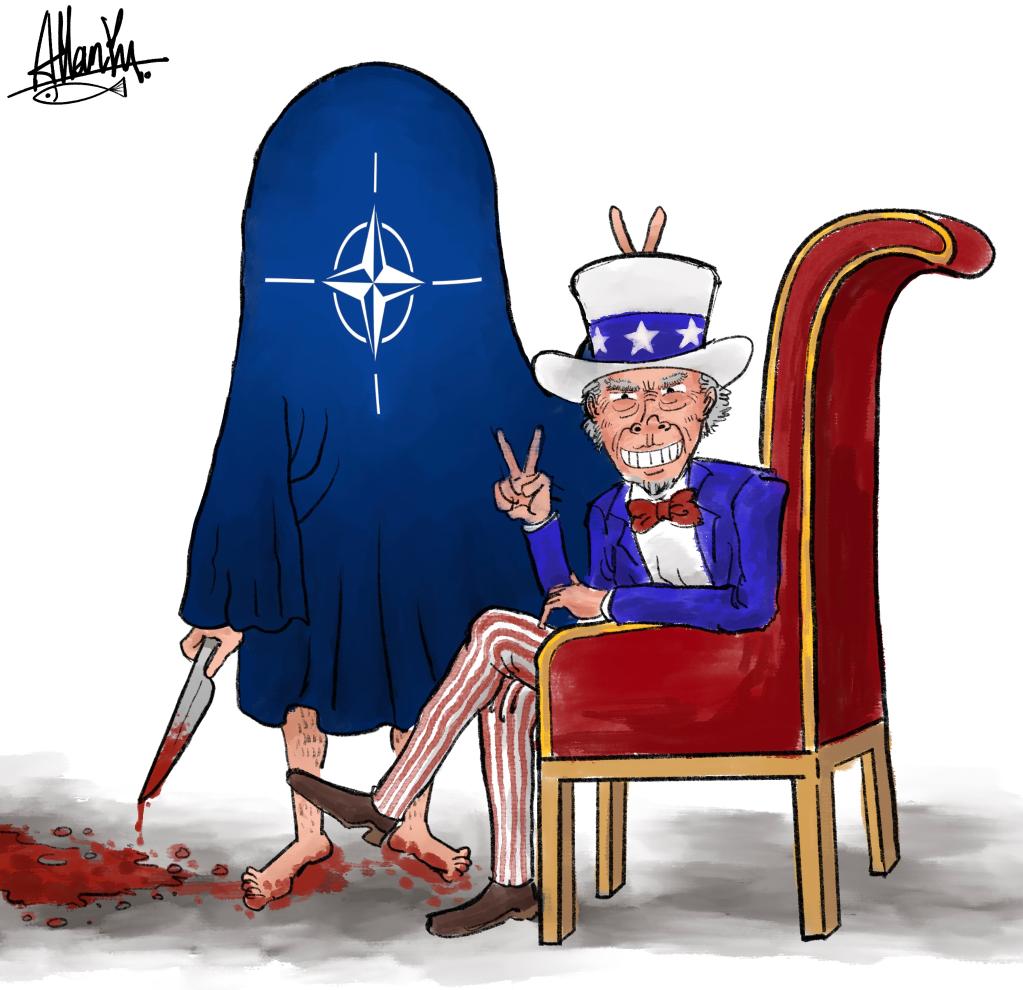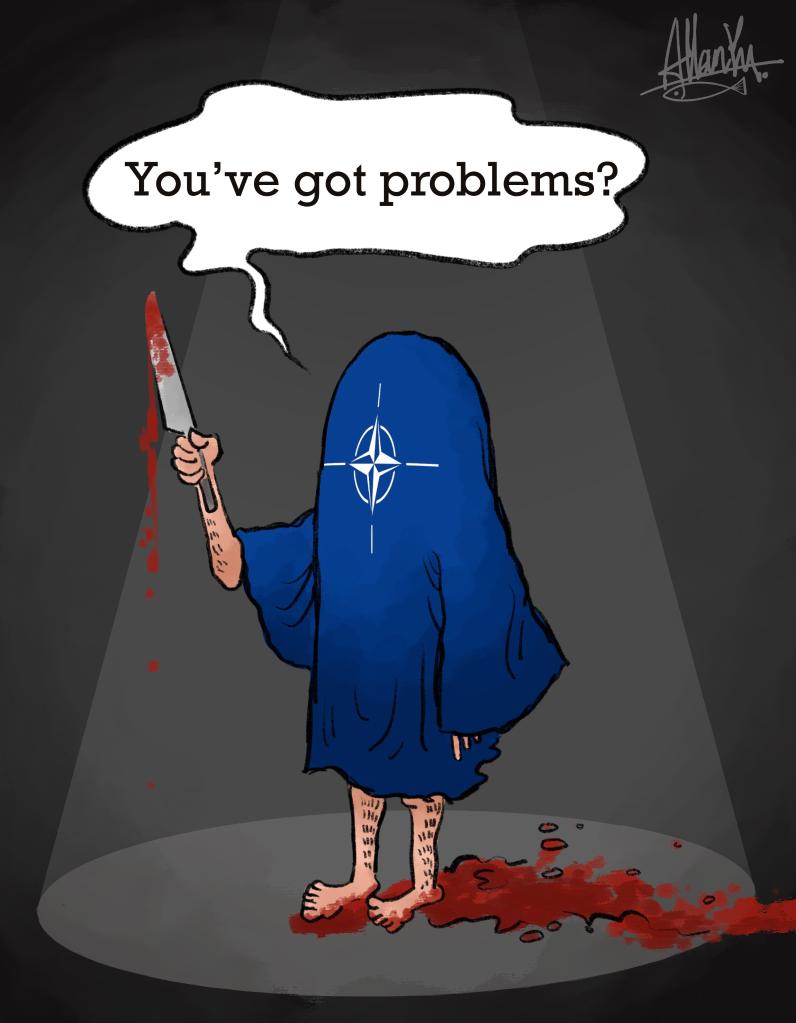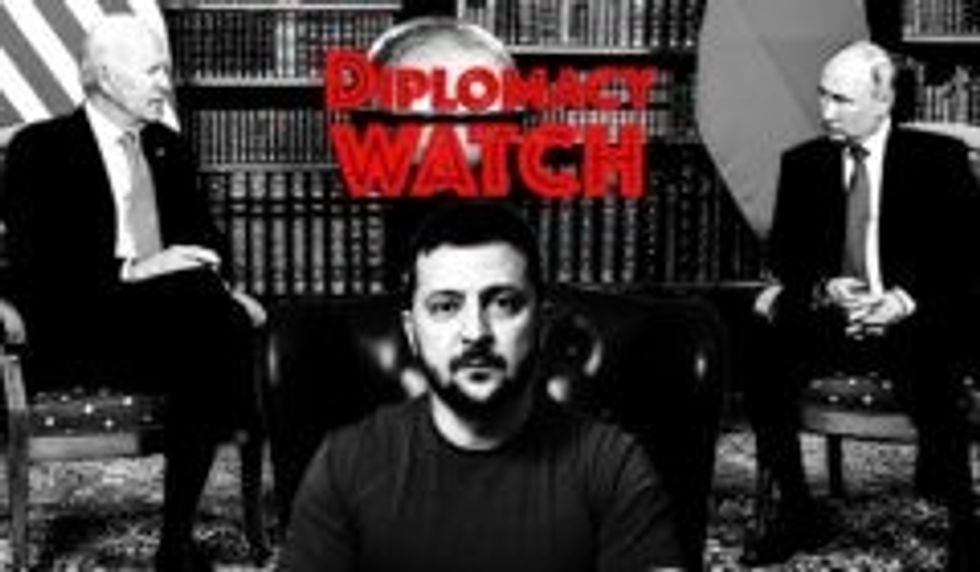/
Uncovering untold secrets of NATO --- monstrous remnant from Cold War days

Source: Xinhua
Editor: huaxia
2022-04-26 19:33:00
Source: Xinhua
Editor: huaxia
2022-04-26 19:33:00
* Both history and military alliance theory seem to predict that once the Cold
* The relationship between the United States and its European allies within NATO is fundamentally unequal. NATO contributes to the United States' hegemonic position in Western Europe by allowing U.S. military bases and troops to be stationed in the region.
* Since 1999, NATO has expanded eastward five times, advancing more than 1,000 km all the way to the Russian border, gradually pushing Russia into a corner.
* NATO forces launched 78 days of bombardment against Yugoslavia in 1999, killing or injuring over 8,000 civilians and displacing approximately 1 million people. Other countries, including Afghanistan, Iraq and Libya, have also fallen victim to the U.S.-led NATO's belligerence and violations of human rights.
BEIJING, April 26 (Xinhua) -- As the Russia-Ukraine conflict rages on, tensions between NATO and Russia have verged on downright hostilities.
The gloomy reality on the ground brings up a question as to why, more than 30 years after the end of the Cold War, the world appears to have regressed to where it ever was.
Thanks to their intentionally neglected nuance in depicting the Russia-Ukraine conflict, Western media have framed Russia as the lone villain. Close scrutiny of regional geopolitics, however, makes clear that NATO, a remnant from Cold War days, bears responsibility for precipitating the current crisis, not least for its relentless expansion at the expense of Russia's security concerns...
GLOBAL PEACE DISRUPTOR
Russia has long been accused by the U.S.-led NATO of violating basic international rules and norms and stoking global instability. Ironically, it is precisely what people in many parts of the world believe Washington and NATO have been doing.
Speaking in March at a ceremony marking the Remembrance Day of victims of the 1999 NATO aggression against the Federal Republic of Yugoslavia, President of the Republic of Serbia Aleksandar Vucic condemned the NATO attack as "brutal, horrible, criminal, (and) inhuman."
Though that small country "hardly did anything wrong to anyone... that small country and great people just wanted to be on their own, to guard their hearths, and nothing more," Vucic said, "some others, 19 big ones, wanted to show all their courage, arrogance and brutality on a small unconquered people like the Serbs."
NATO forces launched 78 days of bombardment against Yugoslavia in 1999, killing or injuring over 8,000 civilians and displacing approximately 1 million people.
Other countries, including Afghanistan, Iraq and Libya, have also fallen victim to the U.S.-led NATO's belligerence and violations of human rights.
In the two-decade-long Afghanistan war fought nominally to protect civilians, NATO's airstrikes have killed thousands of civilians.
Din Mohammad, a 73-year-old Afghan man from the hamlet of Lakani in the Panjwayi district of Kandahar province in south Afghanistan, still remembered the night ten years ago when the U.S. military unleashed airstrikes on his hometown, killing 63 civilians and injuring dozens more.
"The bodies of men, women and children were lying in blood and the crying of the injured was heard from every corner of the house," he told Xinhua.
"Innocent people were killed in their beds without committing any crime," said Mohammad, who lost 17 family members, including five children, that night.

After the U.S.-led NATO intervention in 2011, Libya sank into civil war and became a breeding ground for instability and terrorism.
As Alan Kuperman, associate professor of public affairs at the University of Texas at Austin, has noted, "Libya has not only failed to evolve into a democracy; it has devolved into a failed state. Violent deaths and other human rights abuses have increased severalfold" after the NATO military attacks.
In Iraq, between 184,382 and 207,156 civilians have died from "direct war-related violence caused by the United States, its allies, the Iraqi military and police, and opposition forces" from the time of the invasion through October 2019, according to the Costs of War project at the U.S. Brown University.
The death toll is "likely much higher," as not all war-related deaths were accurately recorded, it said.
(Video reporter: Lu Jiafei, Feng Yasong, Shu Chang, He Fei; Video editors: Lin Lin, Cao Ying, Zhu
>
Duration: 15:55
Posted: May 30, 2022
Home/Articles/Realism & Restraint/The War for Globalism in Ukraine
Washington’s proxy war in Ukraine is the globalist scheme to transcend the continuity of history, culture, and geography embodied in the nation-state.
Beware the redux: America’s violent Cold War history
Hollywood loves a sequel, but the Russia-Ukraine crisis has made the possibility real, and no one should want to see it.

A growing chorus of pundits and policymakers has suggested that Russia’s invasion of Ukraine marks the beginning of a new Cold War. If so, that means trillions of additional dollars for the Pentagon in the years to come coupled with a more aggressive military posture in every corner of the world.
Before this country succumbs to calls for a return to Cold War-style Pentagon spending, it’s important to note that the United States is already spending substantially more than it did at the height of the Korean and Vietnam Wars or, in fact, any other moment in that first Cold War. Even before the invasion of Ukraine began, the Biden administration’s proposed Pentagon budget (as well as related work like nuclear-warhead development at the Department of Energy) was already guaranteed to soar even higher than that, perhaps to $800 billion or more for 2023.
Here’s the irony: going back to Cold War levels of Pentagon funding would mean reducing, not increasing spending. Of course, that’s anything but what the advocates of such military outlays had in mind, even before the present crisis
> REFERENCES AND RESOURCES
Grand Illusions: The Impact of Misperceptions About Russia on U.S. Policy
Getting Russia right—assessing its capabilities and intentions, the long-term drivers of its policy and threat perceptions, as well as its accomplishments—is essential because the alternative of misreading them is a recipe for wasted resources, distorted national priorities, and increased risk of confrontation.
GLOBAL CONFLICT TRACKER Link >> https://www.cfr.org/global-conflict-tracker
HISTORY OF NATO
America’s Longest Foreign Wars
>
Afghanistan
Visualising the impact of 20 years of war
Here's what 20 years of war has done to the Afghan people. As the US withdraws its troops, we look at the latest figures on human suffering.
The human cost of war An estimated 241,000 people have died as a direct result of the war since the US invaded Afghanistan to topple the Taliban in the wake of the September 11, 2001 attacks in the US, according to the most recent figures from Brown University’s Costs of War. Hundreds of thousands more, mostly civilians, have died due to hunger, disease and injury caused by the devastating war. . .
The US and NATO's longest war
The US under President George W Bush invaded Afghanistan on October 7, 2001, less than a month after the September 11 attacks in the US. The coalition he led accused the ruling Taliban regime of harbouring Osama bin Laden, the al-Qaeda leader who claimed responsibility for the attacks.
The war in Afghanistan spanned nearly 20 years and four US presidents.
Over the 20-year war, 50 NATO and partner nations contributed forces to the missions in Afghanistan. At its peak in 2011, nearly 140,000 US and allied forces were in the country.
The economic cost of war
The war in Afghanistan is estimated to have cost the US $2.26 trillion to date, according to the Cost of War project. The bulk of the spending, $933bn, was allocated to the US Department of Defense war budget, later supplemented by another $443bn.
The rest of the money includes $296bn for veterans’ medical and disability care and $59bn towards the Department of State’s war budget. The US has also paid some $530bn in interest for its heavy borrowing throughout the war. The US has spent $144bn on Afghanistan reconstruction initiatives.
These figures do not include the lifetime care for veterans nor future interest payments, which means even after the US leaves Afghanistan it will continue to pay for the war.
====================================================
The US military presence in Europe has been declining for 30 years – the current crisis in Ukraine may reverse that trend
Up to 8,500 U.S. troops could soon be heading to Eastern Europe – bolstering an American military presence in the continent that has been in decline since the end of the Cold War.
News of the possible deployment, announced on Jan. 24, 2022, by the Pentagon, comes as Russia and the United States continue to maneuver in the face of an escalating crisis in Ukraine.
We are a team of researchers who study U.S. troop deployments and how they affect the security, perceptions, economy, social sphere and environment of host countries. Understanding the changing U.S. military commitment to European countries helps us understand what is at stake in Europe and U.S. credibility in the region.
US troop numbers in Europe have fallen since Cold War's end
A significant drop in America's military presence in Europe coincided with the end of the Soviet Union in 1991, and then again as the US got bogged down in conflicts in Iraq and Afghanistan.
>
OFFICAL INFORMATION
Operations and missions: past and present
Last updated: 14 Jun. 2022 13:11
NATO is an active and leading contributor to peace and security on the international stage. It promotes democratic values and is committed to the peaceful resolution of disputes. However, if diplomatic efforts fail, it has the military capacity to undertake crisis management operations alone or in cooperation with other countries and international organisations.
Current operations and missions
Terminated operations and missions
From 1949 to the early 1990s
NATO in Afghanistan - Following the 9/11 terrorist attacks against the United States, the International Security Assistance Force (ISAF) was established under the request of the Afghan authorities and a UN mandate in 2001. ISAF was led by NATO from August 2003 to December 2014 and was succeeded on 1 January 2015 by the Resolute Support Mission (RSM), which was terminated early September 2021.
Operation Active Endeavor - Operation Active Endeavour (OAE) was initiated in the immediate aftermath of the 9/11 terrorist attacks to deter, defend, disrupt and protect against terrorist activity in the Mediterranean. It helped to secure one of the busiest trade routes in the world and was among eight initiatives launched by the Alliance in 2001, in solidarity with the United States. It was an Article 5 operation, i.e., a collective defence operation that, initially only involved NATO member countries until it started accepting non-NATO countries' participation in 2004.
NATO and Iraq - NATO conducted a relatively small but important support operation in Iraq from 2004 to 2011 that consisted of training, mentoring and assisting the Iraqi Security Forces. At the Istanbul Summit in June 2004, the Allies rose above their differences and agreed to be part of the international effort to help Iraq establish effective and accountable security forces. The outcome was the creation of the NATO Training Mission in Iraq (NTM-I). The NTM-I delivered its training, advice and mentoring support in a number of different settings. All NATO member countries contributed to the training effort either in or outside of Iraq, through financial contributions or donations of equipment. In parallel and reinforcing this initiative, NATO also worked with the Iraqi government on a structured cooperation framework to develop the Alliance's long-term relationship with Iraq.
NATO and Libya -
Following the popular uprising against the Gadhafi regime in Benghazi, Libya, in February 2011, the UN Security Council adopted Resolutions 1970 and 1973 in support of the Libyan people, "condemning the gross and systematic violation of human rights". The resolutions introduced active measures including a no-fly zone, an arms embargo and the authorisation for member countries, acting as appropriate through regional organisations, to take "all necessary measures" to protect Libyan civilians.
Initially, NATO enforced the no-fly zone and then, on 31 March 2011, NATO took over sole command and control of all military operations for Libya. The NATO-led Operation Unified Protector had three distinct components:
- the enforcement of an arms embargo on the high seas of the Mediterranean to prevent the transfer of arms, related material and mercenaries to Libya;
- the enforcement of a no-fly-zone in order to prevent any aircraft from bombing civilian targets; and
- air and naval strikes against those military forces involved in attacks or threats to attack Libyan civilians and civilian-populated areas.
The UN mandate was carried out to the letter and the operation was terminated on 31 October 2011 after having fulfilled its objectives.
Assisting the African Union in Darfur, Sudan - The African Union Mission in Sudan (AMIS) aimed to end violence and improve the humanitarian situation in a region that has been suffering from conflict since 2003. From June 2005 to 31 December 2007, NATO provided air transport for some 37,000 AMIS personnel, as well as trained and mentored over 250 AMIS officials. While NATO's support to this mission ended when AMIS was succeeded by the UN-AU Mission in Darfur (UNAMID), the Alliance immediately expressed its readiness to consider any request for support to the new peacekeeping mission.
Second Gulf Conflict - During the second Gulf Conflict, NATO deployed NATO AWACS radar aircraft and air defence batteries to enhance the defence of Türkiye in an operation called Display Deterrence. This operation started on 20 February 2003 and lasted until 16 April 2003. The AWACS aircraft flew 100 missions with a total of 950 flying hours.




No comments:
Post a Comment